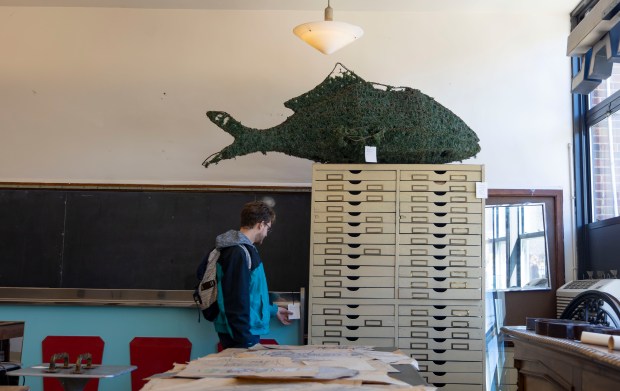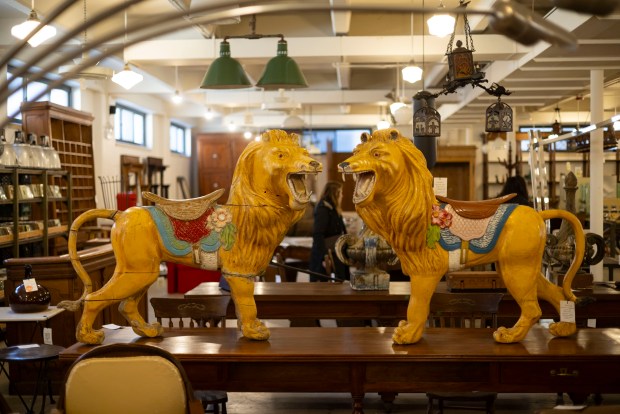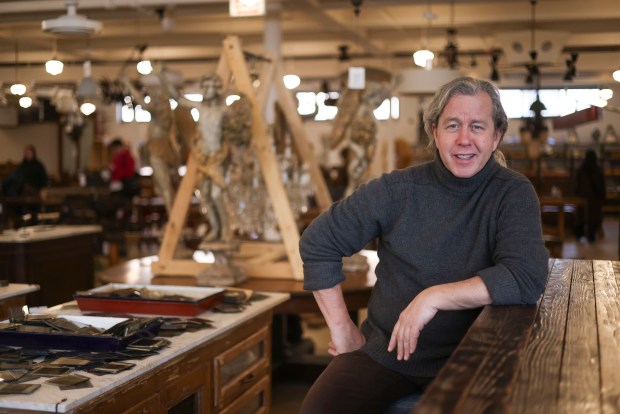Stuart Grannen paused at the threshold of his antique store and welcomed a longtime customer, who breezed in and said, confidingly, she’s sad he’s closing after 37 years, but maybe it’s time to close, because, you know, Chicago, these days — it’s a cesspool.
He nodded, yeah, yeah, politely, not quite committing.
The client, who wore an elegant tan overcoat and expensive neck scarf, spoke in the high-toned register of the monied, rooted and influential, suggesting old-school taste. She mourned a way of life, a feeling that one can’t even visit their old haunts any more.
His complaint, Grannen replied, was a lack of vision; he thinks of Navy Pier, “which could be outrageously wonderful but remains so … average, as mediocre as can be.”
“Vile,” she agreed.
Behind Grannen stood three floors of the way things used to be.
Each landing was occupied with iron posts, facades, ornamental gates, intricately old-fashioned mechanics — everything a kind of proof of not only a bygone Chicago but a lost Italy and Germany, Argentina and places beyond. Behind Grannen stood the 37,000 square feet of space that houses his shop, Architectural Artifacts. It’s been on Orleans Street in River North since 2022. But for 34 years before that, Grannen’s business was legendary, a Ravenswood staple, with such clients as Oprah Winfrey and members of U2 browsing 80,000 square feet of nothing anyone needs.
Or as Grannen calls his wares:
“Completely useless stuff.”
An old cheese case from Parma, Italy. A rusted CTA fare box. A dozen fruit-picking ladders.
And yet, in the right room … it can be the right useless stuff. Once-practical objects, with a little time and dust behind them, have a habit of resembling art.
“I once bought all the topiary they used in ‘Edward Scissorhands’ from the heir to an underwear fortune who died. He was a giant guy and would wear, like, bright orange fur coats made of … you remember furry toilet seats? Made of stuff like that. Wacky dude.”
Grannen is 67 and has the graying hair and sometimes ponytail of someone who has lived quite a life. Without prompting, he told me about an encounter he once found himself in with two female park rangers on Cape Cod. Without reportorial nudging, he told me about the similarities between selling antiques and illegal drugs, both of which he has sold. In fact, some time next month, when he closes Architectural Artifacts after 37 years in Chicago and moves this fabled high-end antique business to the small town of Round Top, Texas (pop. 92), it won’t be because Chicago isn’t the Chicago he knew when he moved here in 1987. It won’t be because of the weather (though that’s part of it). It’ll be because Stuart Grannen spends too much time in his store, sitting, day after day, and Grannen was never the kind of person who was made to sit — never mind for 37 years.
“Most people think of this life as fantastic,” he told me. “But I’m always thinking of the future. There’s more I want to do. I bought an 1880s saloon and dance hall in Round Top, which, three times a year, gets like half-a-million people for big antique sales. Ever heard of Valentine, Texas? Also small. And empty. I’m thinking of buying it. I could make something. I’m leaving Chicago, but am back in Chicago in April to load this place up. Then I’m in Texas, then I go to my house in Argentina, which is being renovated. About mid-May, my girlfriend and I are going to Europe for three months. We rented a camper van. We’ll pick it up in Rome, then head into the Adriatic, then through Scandinavia, back to Lithuania, Latvia, and blah, blah, blah, down through the Adriatic again, over to Greece, over to Turkey. Hopefully I won’t be doing any business then — but it always comes up!”

Architecture Artifacts is known for such impractical, rare and often expensive objects, I asked if, all these years later, could he actually say that he is an antique-store owner?
He thought a moment. He didn’t know what else to call what he did. He said people think of antique dealers as “old dudes with half-dead cats, wearing cardigans, selling a bunch of (expletive).” But he sells design, architecture, art. … He paused for a second.
He was surrounded by, among many, many other things:
A large bin full of papier-mache masks from a Munich opera house.
Two lions from a French carousel.
A pile of spools of silks from the former Merwitz Textiles of Chicago.
“OK, truthfully? I don’t know what the hell you call this stuff.”


He reached for a metaphor:
“If the normal antique store is run by a guy who likes to smoke a joint occasionally and maybe drink a little beer, this place is like how I used to do drugs — more, more, more!”
Grannen said he grew up very wealthy in New Jersey, the son of an international industrialist; his father controlled chemical plants all over the world. But vacations, Grannen recalled, consisted of the whole family driving up and down the East Coast — Rhode Island, Maine, Maryland — “buying the best of the best antiques, formal Americana, Philadelphia highboys, Boston highboys. My father owned the world’s finest antique tool collection, which I sold to the Henry Ford Museum (in Michigan). My father was a successful guy.”
Grannen studied archeology at the University of Tennessee, and by his late 20s, he owned an architecturally oriented resale business in Minneapolis. He also had a major drug addiction. Cocaine. Heroin. His trajectory to Chicago came in the wake of that low point, after the worst of the worst. He left a drug treatment program in Minnesota — he’s been sober since, he said — and hitchhiked down to Chicago, on the hope that he could salvage a mountain of treasures from the imminent demolition of Block 37 in the Loop.
He did, and partly using remains from that chunk of old Chicago, he built Architectural Artifacts. He kept an eye out for the unusual. Among the first pieces in the shop was an early driver’s education car from Lane Tech — a row of oak seats, primitive turn signals.
He got very aggressive about buying fresh objects. He made friends with historians, collectors, architects; he counts Tim Samuelson, the retired city historian, among his close friends. He placed full-page ads in the Chicago Reader, seeking the strange and rare. He was sought out by David Byrne, Richard Driehaus, Annie Leibovitz, Art Smith, John Hughes. For decades, he traveled the world several times a year, salvaging friezes from abandoned churches and bartering with rare-antique dealers in far-flung towns. He could afford to. He would simply offer some cash when he noticed something.
“Believe it or not, I noticed that people around here had stuff in their yards. I would spot marble statues from the 1893 World’s (Columbian Exposition), just sitting in some yard. I would think whoa, then ask: ‘Want to sell that?’ And soon, things were coming to me.
“A lot of Chicago dealers, they hated me. I was buying everything in sight.”
He was not modest. Even now, most of the fonts on his website are all-caps. He bought chandeliers out of bankrupt theaters and terra cotta from renovating landmarks. He owned a lot. He bought so much he needed warehouses for storage. He also bought houses for himself around the world. Havana, New Orleans, Buenos Aires, Michigan. He bought a farmhouse in the Hamptons once owned by a lover of Jackson Pollock; Ralph Lauren, another client, had a house down the street. In Chicago, he moved into a building across from the Hideout on the north branch of the Chicago River. He plans to hold onto properties in Chicago, including on Ada Street, much of which he also owns.
But this large midcentury building on North Orleans that Architectural Artifacts is exiting — the former home of Immaculate Conception, St. Joseph School — Grannen sold. He bought it a few years ago with plans to turn it into a boutique hotel, but when the pandemic struck and hotels seemed iffier, he moved the antique business in, added a pickleball court to the gym and a small cafe and rechristened the space The School House.
It still has the echo of an old school, the wide stairwells perfect for stampeding children.
Grannen filled it all, especially the classrooms.
Those rooms are emptier since he announced he was leaving, but they’re still pretty packed. He was doing $10,000 a day in business; after the announcement, he says he’s been doing closer to $50,000 a day. And despite a coming move, he hasn’t stopped haggling. He was about to buy a pair of bronze bank tables accented with dragons. He just sold a huge, room-filling electronic scoreboard to a bar; he wanted $3,600 but took $1,500. “I don’t want to move that damn thing!” he said, looking about an old classroom.

We passed a large bust labeled: “Italian bronze sculpture of an important dude.” And a larger bust of the Biblical Noah — “from when he came out of the desert, but I didn’t know!” He has a pair of javelins and a gleaming black prosciutto-slicing machine. He has an acid-proof vat that holds 1,000 liters and wooden chairs from the beloved bygone Cicero restaurant Klas. He has bits of buildings by Frank Lloyd Wright and Louis Sullivan, and decor from Mecca Flats, the apartment complex on 34th Street that became a touchstone of the Black middle class. (He donated other parts of Mecca to the Smithsonian’s National Museum of African American History and Culture.) He’s bought parts of the Rand McNally Building, the Medinah Temple, the Chicago Stock Exchange.
He said the paper trail on some of this stuff could get vague, but the vast majority found its way here legally, either being discarded or sold or, as he has done, removed from buildings being gutted. “On the other hand, if someone brought me something they just found from the Uptown Theatre on Broadway? A good chance that that’s been stolen.”
We passed ornamental grates from the Drake Hotel and rusted cages used to transport shellfish, a storage bin from an old Alka-Seltzer factory and faux mummies “that were made by some Belgian artist and were fairly important though I forget why the hell why.”
A customer approached. He wanted to know the prices of a stack of loose photographs. Well, let’s say, Grannen said, $10 each. The man did a double-take and grinned:
“Oh, I’m not paying that. Maybe 10 for the stack?”
“No,” Grannen said, “I’ll give them to a kid with his parents who gets more pleasure out of them.”
The guy wandered off, shaking his head.
“In the old days, you sold anything,” Grannen told me. “There was appetite. Now people don’t have money. Everything is thought out. A lot of my business is to hotels, restaurants, high-end folks. It’s more fun to buy when people know what they are doing. But now I can sell something for $10,000 easier than I can sell a $45 doorknob. Because $45 doorknob people are freaks.” He held up a chunk of type, the letter “V.” “I will sell a $10,000 drinking bar faster than I will sell this ‘V,’ because inevitably the wacko looking for this letter will decide that it’s just not the right ‘V’ for them.” He sighed.
Everything must go, but it probably won’t. Not before April anyway. There’s too much here.
My eye caught a row of stiff, white plaster hands arranged in a long row. “Molds, from a factory that made rubber gloves,” Grannen explained. “Beautiful — just not very useful.”
cborrelli@chicagotribune.com





